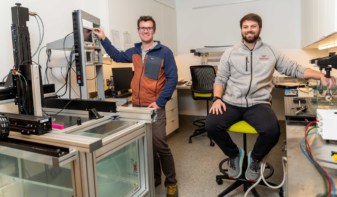Intracranial pressure (ICP) is an important parameter in the monitoring of critical-care patients, but it can currently only be obtained accurately via invasive methods. Researchers from Germany have now shown that a new commercial device could offer a non-invasive alternative that they believe could pave the way to safer and more widespread ICP monitoring (J. Neurosurg. doi: 10.3171/2016.11.JNS152268).
The research team, from Klinikum Stuttgart and the University of Erlangen, tested the performance of the HS-1000 system from HeadSense Medical Ltd. Positioned close to the ear, the device emits a short burst of sound at 66 dB, generating an acoustic wave that travels through the cranium. The acoustic signal, along with other physiological sounds, is collected at the opposite ear, with subsequent signal processing yielding a measurement of ICP.
The experiment involved 14 patients who were being treated for traumatic brain injury or subarachnoid haemorrhage (bleeding between the brain and its surrounding tissues). In total, more than 2000 pressure points were acquired using the acoustic method, and then compared with conventional ICP measurements taken at the same time.
The statistical analysis seems to indicate that the method could offer a viable way to measure ICP non-invasively. Comparing the data revealed a strong correlation between the two methods (r=0.82; p<0.0001), with a more refined analysis showing that 63% of the paired-data measurements were ±3 mmHg of each other and 85% within ±5 mmHg. Similar differences have been reported between current gold-standard invasive methods.
An important clinical parameter
ICP is commonly recorded in intensive care units to track changes in pressure and prevent further damages to the brain. The gold standard method requires a hole to be drilled in the patient’s skull to allow a catheter to be inserted into brain tissue or the ventricle, the part of the brain that is filled with cerebrospinal fluid. In the latter instance, the catheter can both monitor ICP and reduce it by extracting excess cerebrospinal fluids. But despite this advantage, ICP recording via catheters is technically difficult and carries risks of infection, bleeding or further damages to the brain tissues.
This is not the first time that researchers have attempted to develop non-invasive methods as an alternative to catheter-based ICP recordings. Previous studies have investigated, for example, surrogate techniques such as Doppler ultrasound scanning of the brain, or tracking the tympanic membrane displacement and optic-nerve sheath diameter. However, they have all so far proved too inaccurate to be used routinely. The normal ICP in humans is usually around 20 mmHg, which means that an error of more than 5 mmHg could have fatal consequences for the patient.
A first step toward easier ICP monitoring
Although the results presented in the study are only preliminary and requires further investigations, this is the first time that a non-invasive technique exhibits such accuracy in ICP measurements. This new technology therefore offers a promising route to making ICP monitoring easier and more widespread in clinical practices.



